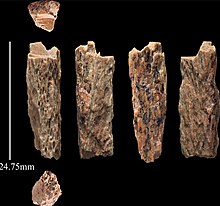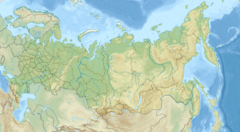Denny (hybrid hominin)
 | |
| Catalog no. | DC1227; GenBank Accession = KU131206 |
|---|---|
| Common name | Denny, Denisovan 11 |
| Species | 1st generation Neanderthal/Denisovan hybrid |
| Age | 90,000 years |
| Place discovered | Denisova Cave in the Altai Mountains, Siberia, Russia |
| Date discovered | 2012 |
| Discovered by | Viviane Slon and Svante Pääbo |

Denny (Denisovan 11) is a fossil from a girl who was at least 13 years old and lived some 90,000 years ago, shown to be an archaic human hybrid that was half Neanderthal and half Denisovan.[1][2] Denny was found in 2012 and she represents the first time an ancient individual was discovered whose parents belonged to two distinct species of humans.[1][2] Her DNA allows for extensive comparative genetic studies between human species, and may inform the frequency of interspecies hominin breeding and its influence on the evolution of modern humans.
The initial genetic analysis was led by palaeo-geneticists Viviane Slon and Svante Pääbo of the Max Planck Institute for Evolutionary Anthropology in Leipzig, Germany.[1]
Overview[]
Dating analyses in 2016 determined that this individual died about 90,000 years ago, and the bone fragment's characteristics indicate an age of at least 13 years. An analysis of the whole genome sequence (total mitochondrial and nuclear DNA) indicates she was female,[1][2] with a Neanderthal mother and a Denisovan father.[1][2] While previous analyses of other ancient genomes concluded that Denisovans, Neanderthals, and modern humans interbred during the ice age in Europe and Asia, this find is the most direct evidence yet that various ancient hominins mated with each other and had offspring.[2][3][4]
Other fossils found in this Siberian cave have previously shown that all three species (modern human, Neanderthal and Denisovan) lived there at different times, and that all three human species interbred with each other.[2][4] The genes of both archaic human species are present in many people today, which suggests that when these groups met, they actually mixed with each other.[2][3] It is not evident if the mating was consensual,[1] or if the offspring were fertile.[1] Some of the researchers involved think that this discovery supports the previous notion that Neanderthals and Denisovans may not have undergone extinction, but assimilation into modern human populations.[4]
Discovery[]


The find consists of a single bone fragment about 2 cm long that was unearthed in 2012 by Russian archeologists at the Denisova Cave,[5] from layer 12 of the East Gallery. The cave is located in Denisova valley, Altai Mountains at Siberia, Russia.[2][4] At the time, the origin (species) of the bone fragment was unknown, and it was archived along with other 2,000 non-descript bone fragments from the cave for later identification.[6] In 2016, Samantha Brown, then an MSc student at the University of Oxford,[7] was sorting through the thousands of fragments from the cave, studying the proteins in the bones' collagen to figure out what animal species each one was. Using this method, she identified the bone as hominin.[8][9][10] It was dated to about 90,000 years ago, and the bone thickness was used to determine the person's age, which was at least 13 years old.[6]
At this point, the bone fragment was referred to the Max Planck Institute for Evolutionary Anthropology, that had previously isolated and sequenced Denisovan DNA.[8] The first analysis done at Max Planck was of her mitochondrial DNA, followed by nuclear DNA. The publication of their results in 2018 was the first direct evidence of interbreeding, and it was called a "landmark find […] that is helping shape our understanding of hominin interactions."[8][11]
According to population geneticist Pontus Skoglund from Harvard Medical School, currently at the Francis Crick Institute in London, "To find a first-generation person of mixed ancestry from [Neanderthal and Denisovan groups] is absolutely extraordinary. ... It’s really great science coupled with a little bit of luck. It’s a really clear-cut case. I think it’s going to go into the textbooks right away.”[1]
Description[]
The bone fragment, identified by the code DC1227 (GenBank Accession = KU131206) or as Densiova 11, is from a human arm or leg.[8] Prior to extraction of material for genetic analysis, DC1227 weighed 1.68 g (0.059 oz), and had maximum dimensions of 24.7 mm (0.97 in) by 8.39 mm (0.330 in).[6] In 2016, a team from the Max Planck Institute for Evolutionary Anthropology in Leipzig, Germany, then used a small portion of the bone to isolate mitochondrial DNA, which was found to be fully Neanderthal, indicating she was the daughter of a Neanderthal woman.[2]
Subsequently, analysis of the nuclear genome revealed her father to be Denisovan, but with some Neanderthal ancestry.[2] This genome thus constitutes the first direct evidence for multiple instances of interbreeding between Neandertals and Denisovans.[12]
Researchers determined the girl’s mother was genetically closer to Western European Neanderthals than earlier Neanderthals who lived in Denisova Cave, suggesting some Neanderthals had migrated from Western Europe to Central Eurasia tens of thousands of years before the species died out.[8][2]
Context and implications[]
The hypothesis of interbreeding, also known as hybridization, admixture or hybrid-origin theory, has been discussed ever since the discovery of Neanderthal remains in the 19th century.[13] The linear view of human evolution began to be abandoned in the 1970s as different species of humans were discovered that made the linear concept increasingly unlikely. In the 21st century with the advent of molecular biology techniques and computerization, whole-genome sequencing of Neanderthal and human genome were performed, confirming recent admixture between different human species.[14] In 2010, evidence based on molecular biology was published, revealing unambiguous examples of interbreeding between archaic and modern humans during the Middle Paleolithic and early Upper Paleolithic. It has been demonstrated that interbreeding happened in several independent events that included Neanderthals, Denisovans, as well as several unidentified hominins. Today, approximately 2% of DNA from most Eurasians is Neanderthal, with traces of Denisovan heritage.[8] Also, 4-6% of the genome of modern Melanesian people is Denisovan.[8] Denny represents the first time an ancient individual was discovered whose parents belonged to two discrete species of humans, meaning a 50/50 hybrid, which allows for extensive comparative genetic studies.[1][2]
Although the narratives of human evolution are often contentious, the discovery of Denny and other discoveries since 2010 show that human evolution should not be seen as a simple linear or branched progression, but a mix of related species.[15][16][17][18] In fact, "recent genomic research has shown that hybridization between substantially diverged lineages is the rule, not the exception, in human evolution."[19] Furthermore, it is argued that hybridization was an essential creative force in the emergence of modern humans.[19]
In January 2019, scientists reported that several types of humans, including Denisovans, Neanderthals and related hybrids, may have inhabited the Denisova Cave in Siberia over thousands of years, but it is unclear whether they ever shared the cave.[20]
In February 2019, scientists discovered evidence, based on genetics studies using artificial intelligence (AI), that suggest the existence of an unknown human ancestor species, not Neanderthal, Denisovan or human hybrid (like Denny), in the genome of modern humans.[21][22]
See also[]
- Ardi
- Dawn of Humanity, 2015 PBS documentary
- Homo naledi, a hominin with a mix of ancient and modern humans
- Human evolution
- Interbreeding between archaic and modern humans
- List of human evolution fossils
- Lucy
- Prehistoric Autopsy, 2012 BBC documentary
- Selam
- Taung Child
References[]
- ^ a b c d e f g h i Warren, Matthew (22 August 2018). "Mum's a Neanderthal, Dad's a Denisovan: First discovery of an ancient-human hybrid". Nature. 560 (7719): 417–418. Bibcode:2018Natur.560..417W. doi:10.1038/d41586-018-06004-0. PMID 30135540.
- ^ a b c d e f g h i j k l Vogel, Gretchen (22 August 2018). "This ancient bone belonged to a child of two extinct human species". Science. doi:10.1126/science.aav1858. S2CID 188160693. Retrieved 22 August 2018.
- ^ a b Zimmer, Carl (22 August 2018). "A Blended Family: Her Mother Was Neanderthal, Her Father Something Else Entirely". The New York Times. Retrieved 22 August 2018.
- ^ a b c d Marshall, Michael (22 August 2018). "Prehistoric girl had parents belonging to different human species". New Scientist. Retrieved 22 August 2018.
- ^ Hood, Marlowe (22 August 2018). "Neandertal mother, Denisovan father—Newly-sequenced genome sheds light on interactions between ancient hominins". Phys.org. Retrieved 22 August 2018.
- ^ a b c Brown, Samantha (2016). "Identification of a new hominin bone from Denisova Cave, Siberia using collagen fingerprinting and mitochondrial DNA analysis". Scientific Reports. 6: 23559. Bibcode:2016NatSR...623559B. doi:10.1038/srep23559. PMC 4810434. PMID 27020421.
- ^ "Discovering the world's first ancient human hybrid". University of Oxford. Retrieved 12 March 2021.
- ^ a b c d e f g Wei-Haas, Maya (22 August 2018). "Ancient Girl's Parents Were Two Different Human Species". National Geographic. Retrieved 22 August 2018.
- ^ Brown, Samantha (2016). "Identification of a new hominin bone from Denisova Cave, Siberia using collagen fingerprinting and mitochondrial DNA analysis". Scientific Reports. 6: 23559. Bibcode:2016NatSR...623559B. doi:10.1038/srep23559. PMC 4810434. PMID 27020421..
- ^ "Novel collagen fingerprinting identifies a Neanderthal bone among 2,000 fragments". University of Oxford. University of Oxford. 29 March 2016. Retrieved 1 April 2016.
- ^ Zhang, Sarah (22 August 2018). "Scientists Stunned By a Neanderthal Hybrid Discovered in a Siberian Cave". The Atlantic. Retrieved 22 August 2018.
- ^ Scharping, Nathaniel (22 August 2018). "Hybrid Hominin: This Girl's Mother and Father Came From Two Different Species". Discover. Retrieved 22 August 2018.
- ^ Huxley, T. (1890). "The Aryan Question and Pre-Historic Man". Collected Essays: Volume VII, Man's Place in Nature.
- ^ Green, R.E.; Krause, J.; Briggs, A.W.; Maricic, T.; Stenzel, U.; Kircher, M.; et al. (2010). "A Draft Sequence of the Neandertal Genome". Science. 328 (5979): 710–22. Bibcode:2010Sci...328..710G. doi:10.1126/science.1188021. PMC 5100745. PMID 20448178.
- ^ Reich, D.; Green, R.E.; Kircher, M.; et al. (2010). "Genetic history of an archaic hominin group from Denisova Cave in Siberia" (PDF). Nature. 468 (7327): 1053–60. Bibcode:2010Natur.468.1053R. doi:10.1038/nature09710. hdl:10230/25596. PMC 4306417. PMID 21179161.
- ^ Antrosio, Jason (2011). "Denisovans & Neandertals". Living Anthropologically.
- ^ Hammer, Michael F. (May 2013). "Human Hybrids" (PDF). Scientific American. 308 (5): 66–71. Bibcode:2013SciAm.308e..66H. doi:10.1038/scientificamerican0513-66. PMID 23627222 – via grochbiology.org.
- ^ Yong, Ed (2011). "Mosaic humans, the hybrid species". New Scientist. 211 (2823): 34–38. Bibcode:2011NewSc.211...34Y. doi:10.1016/S0262-4079(11)61839-3.
- ^ a b Rogers Ackermann, Rebecca; Mackay, Alex; Arnold, Michael L. (2016). "The Hybrid Origin of 'Modern' Humans". Evolutionary Biology. 43: 1–11. doi:10.1007/s11692-015-9348-1. S2CID 14329491.
- ^ Zimmer, Carl (30 January 2019). "High Ceilings and a Lovely View: Denisova Cave Was Home to a Lost Branch of Humanity". The New York Times. Retrieved 31 January 2019.
- ^ Mondal, Mayukh; Bertranpedt, Jaume; Leo, Oscar (16 January 2019). "Approximate Bayesian computation with deep learning supports a third archaic introgression in Asia and Oceania". Nature Communications. 10 (246): 246. Bibcode:2019NatCo..10..246M. doi:10.1038/s41467-018-08089-7. PMC 6335398. PMID 30651539.
- ^ Dockrill, Peter (11 February 2019). "Artificial Intelligence Has Found an Unknown 'Ghost' Ancestor in The Human Genome". ScienceAlert.com. Retrieved 11 February 2019.
Further reading[]
- Viviane Slon; Fabrizio Mafessoni; Benjamin Vernot; et al. (22 August 2018). "The genome of the offspring of a Neanderthal mother and a Denisovan father". Nature. 561 (7721): 1. doi:10.1038/S41586-018-0455-X. ISSN 1476-4687. PMC 6130845. PMID 30135579. Wikidata Q56234568.
External links[]
- Human Timeline (Interactive) – Smithsonian, National Museum of Natural History (August 2016).
- August 2018 events in Asia
- Ancient human genetic history
- Hominid hybrids
- Homo fossils
- August 2018 events in Russia
- 2018 in science
- 2018 archaeological discoveries